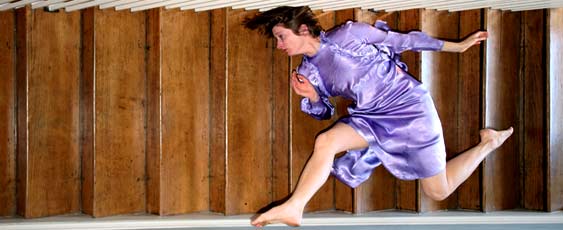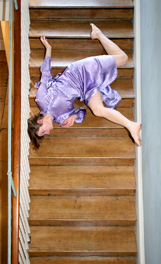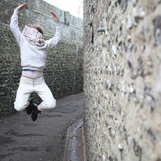
Dances on Street Corners
Virginia Farman trawls and crawls through the streets with Disco Sister's The Original Pedestrian
'The pavement came rolling toward me as a drunk man wearing a large Mexican Sombrero and stinking of Tequila jumped over my body, legs akimbo. He started mumbling something about helping me, I lay trapped between his legs as he wrestled with my mouth preparing to give me mouth to mouth resuscitation.
Sinking down inside myself for what felt like an eternity, I played dead whilst my brain raced desperately to find a non-aggressive way to escape his mouth and now prominent tongue. He staggered and lost his balance on his way toward my head giving me just enough time to slip out and away... The corner was a good 100 yards off, that was five minutes at this incumbent pace of rolling, crawling staggering, like a crippled pilgrim on my knees and belly, to Lourdes. "Whose fucking idea was this? I could get myself hurt" my body contorted in a spasm as I hurled myself toward the corner.'
The Original Pedestrian is a performance event that takes an audience on a journey of approximately a wiggling mile or 50 minutes of performance time, through an inner city landscape. On the journey the two dancers crawl, stagger, roll and fall through a series of improvised choreographies that describe an ant's eye view of the relationship between the environment and the physical body. This is street art that absorbs the street into the feet, mouth and skin of the performer, tattooing the pavement onto our palms as we pay in sweat and bruises to 'reclaim the street' and to re-forge a relationship to public space, female bodies and social interaction.
I first started creating performance work in the late 1980s. There was no established theatre venue for new dance work in my town (Brighton) so I hooked up with the most exciting alternative scene available and went down to the damp dark seafront cellar of the infamous Zap Club where every week there was an 'open stage' event. Having danced with the mistress of anarchic post punk choreography Liz Aggiss and her company Divas for five years I was well schooled in how to conduct myself around the performance repertoire of the weird and the sometimes wonderful. Bird with Ears, Forced Entertainment, The Neo Naturists, Nico, Ian Smith, The Wild Wigglers, to name but a few, were regular visitors to the Zap then, showing work that was dada influenced, highly individual, popularist and totally off the wall.
The explosion of Acid House in '88 birthed a new aesthetic that fused night clubbing with artistic creativity. Clubs became an arena for visual and performance events as a kind of creative competition took over club producers. At this time I was working in close collaboration with composer Daniel Duffell and together we began to develop a synthesis that crossed between work created for theatre and that made for the clubs or site-specific settings.
In 1992 we were invited to join a team of artists creating a club based piece titled Babel Fish. Babel Fish was an all-night performance event that involved 12 dancers. The piece took place within the context of the nightclub and combined set performance with impromptu improvisation. It was during the Babel Fish project that we adopted the company name Disco Sister and began to explore the relationship between the environment, audience and performer in an attempt to bring 'high art to low places'.
Babel Fish initiated a three-year period making work that was presented in both nightclubs and theatres. This work began to define a genre of performance that fused the boundaries of 'normal' behaviour (in this case being at a nightclub) with pre-rehearsed performance behaviour in an attempt to find a balancing point at which the performer's body could fuse with the public and art with regular life.
'The well-dressed neat looking woman didn't want to take the fag butt I was offering her. She kept drawing her body in and shuffling out of my way. I couldn't see her face but I knew that she was close to the edge of her own personal idea of what acceptable social behaviour is. I only wanted her to hold it for a second and I was giving her as much of the "innocent child/cute puppy dog" vibe as I could muster but she wasn't having any of it. Honestly some people don't know how lucky they are, the last person got a piece of broken glass from the piss corner by the railings.'
Setting performance work against a cityscape, shopping precinct, seaside or landscape is like working with a film projection running behind you. The horizon and the sky expand in all directions in an elaborate moving backdrop, this can be, at worse, chaotic, uncontrollable, unfocused and disorientating and at best, exciting, synchronistic, refreshing, accessible and lively. Time and audiences are also affected by the continuation of everyday activity alongside a live art work. Time takes on several tempos, that which is bound into the performance narrative or image and that which is connected to the surroundings; this creates co-existent time frames and a great sense of fantasy. The audiences of street art also become distinguished from the people passing by through their association with the performers and their attention to them, making them part of the performance rather than part of the public.
Enjoyment of 'wide horizons' led me to work on site-specific productions. The West Pier Show, Brighton 1995 was the first of these events. The West Pier is a location that holds deep significance for the local community in Brighton and everyone had some kind of feeling toward it. In creating the performance in this location we tuned into that feeling of the place and the piece was made out of and in response to it. The West Pier Show was a truly site-specific event that was only performed in that site.
Since then most of the outdoor work that I have created has been site generic rather than specific - outdoor work designed for a kind of site rather than a specific place. Within it, the landscape acts like a map or score for the performers to interpret or respond to with recurring common features being used to trigger aspects of the performance.
How we use public space is directly connected to our social and economic status, gender, age and racial heritage. Traditionally, women's movement in public, especially at night, has been limited by social etiquette and controlled by fear. When women venture out into the night they are seen as deliberately positioning their physical bodies in danger from (usually male) aggressors or advances.
As a female performer who works outdoors with the body through dance, I am interested in the relationship that my body has to the environment and the encoding that its positioning carries. Hence the title of this article 'dances on street corners' which ties me into the idea of women standing on street corners at night.
'The pelican crossings were the worst, no matter how many times I performed this piece, crawling across the pelican crossings went against my intuition and made every cell in my body cringe. My head was so close to the car bumper, it was an act of personal and public defiance, a mad artist brain idea that said we must crawl at least one of the 3 road crossings on our journey.'
The image of public space as dangerous space increasingly affects the whole population as public space is becoming more and more encoded, controlled and restricted. The threat of danger (and security against it) has a contracting effect upon the body and results in limiting our activity and expression until we are left with shopping and walking as the only acceptable behaviour in public. Creating and watching performance in public spaces is an alternative activity that reinforces the idea of community, diversity and expression - and performance in public locations celebrates and expands the definitions of how we interact in public by creating new images, uses, rituals, languages and meanings within the space.
Human Beings are wild, I refuse to be kept in or out and my body will not easily conform.
Reflections:
- Cos I'm a Woman,
W-O-M-A-N
Miriam King
Dramaturgy in Action
Beccy Smith
Big Daddy versus
Mother Hen
Marigold Hughes
Through the Threshold
Carran Waterfield
A Woman's Place
Alex Hoare
The Mother
Dorothy Max Prior
Dances on Street Corners
Virginia Farman
Wollstonecraft Live!
Anna Birch
The Right Kit
Alex Mermikides
Going to Extremes
Dorothy Max Prior




